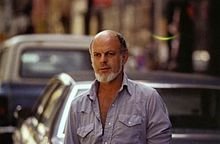Bucky Schwartz
Photograph source
From Artist’s Website
Born in Jerusalem and originally trained as a sculptor in Israel, Schwartz moved to London in 1959, where he played an important role in the hotbed of new sculptural directions at St. Martin’s School of Art during the 1960s. in 1971 Schwartz moved to New York, where he continued to reside part of each year. During the 1960s and 1970s Schwartz’s inventive use of sculptural materials, such as mirrors and wooden timbers, involved an interplay between illusory appearances and the actual, physical presence, weight, and structure of his work. This playful interaction between sculptural appearance and physical reality quickly became a central aspect in much of his video installation work as he added that modern medium to his vocabulary in the late 1970s.
Schwartz’s videoconstructions have been essentially of two types: objects, sculptural presences that incorporate video monitors and around which the viewer moves; and environments,which are akin to architectural interiors in that the viewer is surrounded by forms and colors, including closed-circuit video imagery.
Schwartz’s creative use of the electronic medium of video, and the complex and emphatic manner in which he integrates the viewer into his video work, are both related to central aspects of twentieth-century art. Thus Schwartz’s work is of interest not simply for itself, but for its place in modern art as well.
Acclaimed in three worlds – Europe, Israel, and the United States – Schwartz’s work has been included in the Venice Biennale (1966), the Whitney Biennial (1981) in New York, the Carengie International (1982) in Pittsburgh, and Documenta (1987) in Kassel. He was also represented in such leading historical surveys of video art as A History of Video Art (1984) at the Museum of Modern Art, New York, and Video Skulptur (1989), Cologne. His work has had numerous presentations in one-person and group exhibitions at galleries and museums throughout the world and is included in several private and public collections, most notably: Whitney Museum, N.Y.C, Guggenheim Museum, N.Y.C, and Smithsonian American Art Museum, Washington DC.
Buky Schwartz (Israeli, 1932-2009) Five Chairs with Poems, 1994
Buky Schwartz, Israeli (1932-2009). Limited edition abstract geometric sculpture, brushed aluminum on anodized metal base, 1973.



